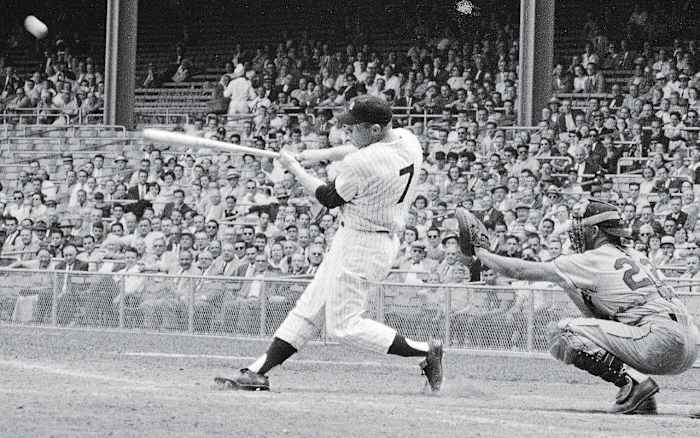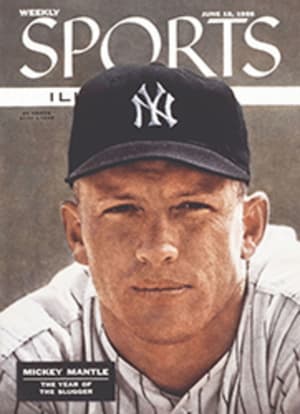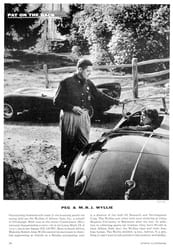The Mantle of the Babe
A thick-bodied, pleasant-faced young man, carrying a bat, stood at home plate in Yankee Stadium, turned the blond bullet head on his bull's neck toward Pedro Ramos, a pitcher in the employ of the Washington Senators, watched intently the flight of the baseball thrown toward him, bent his knees, dropped his right shoulder slightly toward the ball, clenched his bat and raised it to a near-perfect perpendicular. Twisting his massive torso under the guidance of a magnificently tuned set of reflexes, Mickey Mantle so controlled the exorbitant strength generated by his legs, back, shoulders and arms that he brought his bat through the plane of the flight of the pitch with a precision which propelled the ball immensely high and far toward the right-field roof, so high and far that oldtimers in the crowd—thinking perhaps of Babe Ruth—watched in awe and held their breath.
For no one had ever hit a fair ball over the majestic height of the gray-green facade that looms above the three tiers of grandstand seats in this, the greatest of ball parks.
Indeed, in the 33 years since the Stadium was opened not one of the great company of home run hitters who have batted there—the list includes Babe Ruth, Lou Gehrig, Joe DiMaggio, Jimmy Foxx, Hank Greenberg and about everyone else you can think of—had even come close to hitting a fair ball over the giant-sized filigree hanging from the lip of the stands which in both right and left field hook far into fair territory toward the bleachers.
Mantle hit the filigree. He came so close to making history that he made it.
The ball struck high on the façade, barely a foot or two below the edge of the roof. Ever since, as people come into the stadium and find their seats, almost invariably their eyes wander to The Spot. Arms point and people stare in admiration. Then they turn to the field and seek out Mantle.
On that same day that he hit the façade Mantle hit a second homer. This one was his 20th of the season and it put him at that date (May 30) 12 games ahead of the pace Babe Ruth followed when he established his quasi-sacred record of 60 in 1927. Other players in other years had excitingly chased Ruth's record. But Mantle, somehow, seemed different from earlier pretenders to Ruth's crown and different, too, from slugging contemporaries like Yogi Berra, whose great skill seems almost methodical, and Dale Long, who is still, despite all, an unknown quantity.
The excitement surrounding Mantle goes beyond numbers, beyond homers hit and homers and games to go. Like Ruth, his violent strength is held in a sheath of powerful, controlled grace. Like Ruth, he makes home run hitting simple and exciting at the same time. The distance he hits his home runs (the approved cliché is "Ruthian blast") takes away the onus of cheapness, a word often applied to the common variety of home run hit today, and leaves the spectator aghast, whether he roots for Mantle or against him.
All this holds true despite the hard fact that heretofore in his five years in the major leagues the most home runs Mantle has hit in one season is 37, whereas Ruth hit 40 or more 11 different times, and two dozen others have hit 40 or more at least once.
Yet where others impress, Mantle awes, and even the knowing professional speaks reverently of him. Harvey Kuenn, the shortstop of the Detroit Tigers and a topflight hitter in his own right, listened as Sportscaster Howard Cosell, an eyewitness, described the Memorial Day home run to him.
"Did he really hit it up there?" Kuenn asked, knowing but not believing. "Really?" He shook his head. "His strength isn't human," he said. "How can a man hit a ball that hard?"
Marty Marion, the unexcitable manager of the Chicago White Sox, described a homer Mantle had hit against the Sox with two out in the ninth to tie a game the Yankees eventually won. "It went way up there," Marty said, with a wry little grin, pointing to the far reaches of the upper stands in deep right-center field. "Way up there. He swung just as easy and whup! It was gone. Way up there. I never saw anything like it."
As for the nonprofessional, there is no question that Mantle is the new excitement, the new Ruth. Like Ruth, he is known to those who don't know baseball, magically, the way Ruth was. A 7-year-old boy, just on the edge of interest in baseball and in bed getting over the measles, watched part of a Yankee game on television. Later he was not quite sure what teams had been playing and he wasn't positive of the score, but when he was asked if he had seen Mickey Mantle bat, his red-speckled face lit up and he said, excitedly, "He hit a big one!"
Of course, Mantle wasn't the only one to hit "big ones" in this year of the slugger. Some said the 1956 version of the lively ball (see box next page) was responsible for the increasingly bullish market in home runs. Others gave credit (or blame) to the growing popularity of the slender-handled willow-wand bat, which bends like a reed when swung hard and breaks easily but which combines concentrated mass and blinding velocity much the way a golf club does. Mantle uses a 32-ounce bat when he hits left handed, 10 ounces lighter than the bat Ruth used.
Whatever the reason, 19 players had hit 10 or more home runs by June 11, an unprecedented number. But Mantle towered above this forest of hitters both for quality and quantity of his home runs. By June 11 only Ruth had hit more home runs up to that point in a season (see box opposite page).
Most of the managers in the American League marveled at Mantle's strength and hoped that the heat of summer and the law of averages would slow him down. Lou Boudreau of the Kansas City Athletics turned to more immediate and dramatic means. Boudreau is an eminently practical man who said sorrowfully of the lively ball that, while other teams must be hitting it, no one ever seemed to throw it to his batters. When the Athletics came into Yankee Stadium a week ago Boudreau carried with him a sheet of paper on which was scribbled a baseball diamond and nine Xs.
When Mantle came to bat in the first inning with two out and the bases empty the Athletics in the field deployed to points approximating the Xs on Boudreau's map. The effect was slightly sensational. It was the Boudreau Shift, with radical variations that included a left fielder playing an extremely deep third base and a third baseman playing a shallow center field. Everyone remembered at once that it was Boudreau, then manager of the Cleveland Indians, who devised the shift in 1946 to stop Ted Williams, and that Manager Eddie Dyer of the St. Louis Cardinals used it in the World Series that year to smother Williams' bat—five singles in 25 at bats in seven games.
But Williams was a slow runner and an unreconstructed right-field pull hitter, whereas Mantle is a switch hitter who knocks the ball well to all fields whether he's batting left handed or right handed. More than that, Mantle is a superb bunter and the fastest man in baseball down to first base.
Everyone waited for Mickey to bunt the Athletics blind, but the pitcher, the erratic Lou Kretlow, had sufficient control of his rising fast ball that night to keep it high and close, with the result that Mantle fouled off all three of the bunts he attempted. He struck out twice (though later in the game, with a man on base and the shift off, he hit a home run) and the next day struck out once more. In the three games against Kansas City he had four base hits in 13 times at bat, which isn't bad: a .308 batting average. But, truth to tell, the shift seemed to affect Mantle's poise at the plate.
TO FAN OR NOT TO FAN
The strikeouts were a symptom. Mantle's greatest problem in his first five years in the majors was a tendency to strike out. This year in spring training he restrained his need to crush the ball with his bat every time he swung, and he struck out only once in the exhibition season. This restraint, applied in the regular season, did not keep his strikeout total quite so dramatically low but it did increase his control of the bat, his ability to meet the ball and, therefore, his domination over the pitcher. Meeting the ball gave him a lot more line-drive base hits and a batting average that has scorched along near or above .400 all season, and his natural strength sent more of those base hits over the outfield barriers than ever before.
Whether or not it was the real or psychological effect of the shift, Mantle's home run pace slowed abruptly in the first week of June. About the shift, Yankee General Manager George Weiss voiced a remark which was something less than a compliment to Mickey's still-maturing self-discipline: "It got him thinking, and that's bad."
Manager Casey Stengel growled around the New York Yankee clubhouse, arguing that the shift made little sense.
"Here's a man can bunt and run down to first base," Stengel said. "If he bunts 10 times he'll get on base five and that's a .500 average. If he hits he'll hit as many home runs as he would anyway because there isn't anyone in the world can catch a ball in the upper stands or the lower stands. Those guys out in left field and right field may catch a couple of long balls, but we have no one on base and we wouldn't score a run anyway and if he bunts who's up next? Berra. Am I right?"
But it seemed to gnaw on Stengel. Here was Mantle, for the first time in his career quietly confident in his own ability, poised and sure of himself, and here was that damned shift and the possibility that Mantle might start to press thinking about it. George Weiss stayed a little worried, too. "I think he ought to just stand up there and hit," George suggested. "Just forget about the shift."
Mantle, while sloughing off from his rapid-fire home run pace, had no cause to worry, not yet, at any rate. All the great home run hitters produced their homers at an uneven tempo. All had one brilliant run (remarkably similar to Mantle's burst of 20 in 41 games), a good secondary cluster (which Mantle, hopefully, will have, too) and a series of dry spells. Jimmy Foxx, who at 24 (Mantle's age) hit 58 home runs in 1932, had one long good surge in May and June (22 in 44 games) and a long lukewarm period in midsummer. But twice he went through 10 straight games without a single homer.
No one was more erratic than Hank Greenberg when he hit 58 in 1938. He went along evenly at first until June 1, when he fell into an abject slump and hit only one home run in the next 16 games. Once that was over he started up like an outboard motor: a sputter of home runs, a brief hesitation, another sputter, another, and then b-r-r-r-r-r-r! through the end of July. He hit 23 home runs in only 38 games, the greatest sustained streak of home run hitting of any of the great sluggers. It ended in a wild crescendo: a home run on July 24, two on July 26, two more on July 27, two more on July 29 and two more on July 30. Then the motor stalled and in the following 17 games Greenberg added just one. In mid-August he came alive again and hit a blistering 20 in the next 40 games. Five days before the end of the season Hank had his 58 home runs. He needed but two more to tie Ruth, three to beat him. What happened? Well, you remember those outboard motors of the '30s. Didn't some of them pick the most frustrating times to konk out?
Ruth himself was erratic. In 1927 he raced through May and into the middle of June, the pace that Mantle has been surpassing. From mid-June until mid-August he slowed down to a comparative crawl. By August 16 the Babe was 29 games behind his pace when he had hit 59 in 1921. But from then to the end of the season Ruth hit homers at an ever-increasing rate. With nine games to play he was still seven shy of 60. Ruth, ever dramatic, hit the seven, four of them in the last four games.
Some time, maybe, Mantle will have the curiosity to go back some 29 years, to a day of grandeur such as he may live to enjoy himself. If so, this is what he will read in the New York Times of October 1, 1927:
"Babe Ruth scaled the hitherto un-attained heights yesterday. Home Run 60, a terrific smash off the southpaw pitching of Zachary, nestled in the Babe's favorite spot in the right field bleachers....
"When the Babe stepped to the plate in that momentous eighth inning the score was deadlocked. Koenig was on third base, the result of a triple, one man was out and all was tense. It was the Babe's fourth trip to the plate during the afternoon, a base on balls and two singles resulting on his other visits plateward."
A FITTING WALLOP
"The first Zachary offering was a fast one, which sailed over for a called strike. The next was high. The Babe took a vicious swing at the third pitched ball and the bat connected with a crash that was audible in all parts of the stand.... The boys in the bleachers indicated the route of the record homer. It dropped about half way to the top. Boys, No. 60 was some homer, a fitting wallop to top the Babe's record of 59 in 1921.
"While the crowd cheered and the Yankee players roared their greetings the Babe made his triumphant, almost regal tour of the paths. He jogged around slowly, touched each bag firmly and carefully, and when he imbedded his spikes in the rubber disk to record officially Homer 60, hats were tossed in the air, papers were torn up and tossed liberally and the spirit of celebration permeated the place.
"The Babe's stroll out to his position was the signal for a handkerchief salute in which all the bleacherites, to the last man, participated. Jovial Babe entered into the spirit and punctuated his kingly strides with a succession of snappy military salutes....
"The ball...was fast, low and inside. The Babe pulled away from the plate, then stepped into the ball and wham!...it was about 10 feet fair and curving rapidly to the right.
"The ball which became Homer 60 was caught by Joe Forner, of 1937 First Avenue, Manhattan."
Through the jargon of that anonymous writer seeps the unmistakable hallmark of high sporting drama. Whether Mickey himself will ever know a similar moment depends as much on his ability to emulate Ruth's poise and presence and competitive spark as it does on his bat, but his broad, broad back seems ready to receive the mantle of the Babe.


